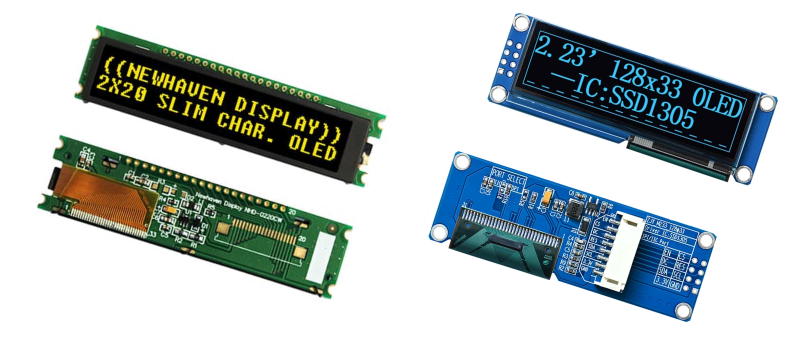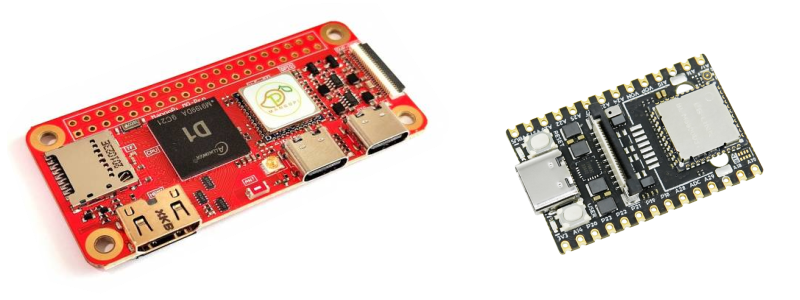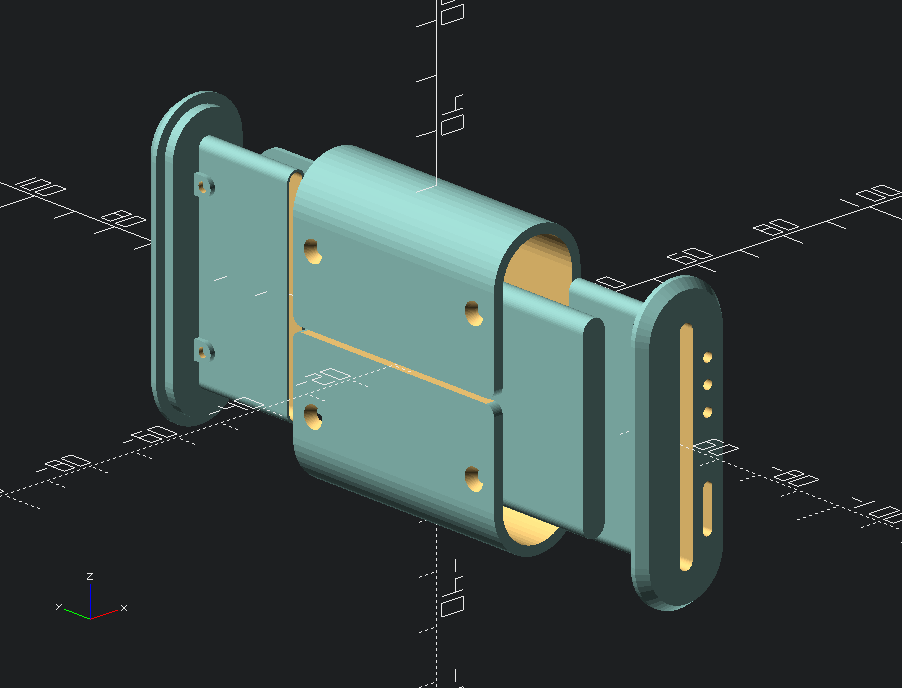NOXA
news
17.06.24long simple display on the side
There are many scenarios in which you use your communication device to get the minimum necessary additional information or feedback in response to your action.
In the same time you don't want to take your phone out of your pocket. For example, if you are listening to music and want to see the track name. Or, let's say you received someone's incoming call or message and you want to identify the sender.
It would be great to have a small screen for these purposes, activated by an event or pressing a button (yep, like on pagers :).
The arrangement of elements inside the NOXA case implies a space in the upper part for a simple long single or double line display. But what kind of display to put there...
I am currently considering two options:
 NHD-0220CW-AY3 Active Area L x W: 73.52mm x 11.52mm
SSD1305 2.23' Active Area: 55.02 * 13.18 (mm)
The first one is good because it is long enough and fits the size. The problem is that it is a) A ready-made module with wiring, and I would like only the screen. I have not been able to find the screen itself separately yet; b) The price of OLED screen of this size seems to me a bit m... to high; c) The module is discontinued and it is not clear whether they still produce such display itself.
The second one is short. But, in all likelihood, I would try it first.
There is, of course, a delusional idea to use two small ones like SSD1315 (26x8mm). Especially since i2c easily allows us to add as many as 127 units on bus. However, common sense tells me that this is not a very nice solution.
Searching continuing...
NHD-0220CW-AY3 Active Area L x W: 73.52mm x 11.52mm
SSD1305 2.23' Active Area: 55.02 * 13.18 (mm)
The first one is good because it is long enough and fits the size. The problem is that it is a) A ready-made module with wiring, and I would like only the screen. I have not been able to find the screen itself separately yet; b) The price of OLED screen of this size seems to me a bit m... to high; c) The module is discontinued and it is not clear whether they still produce such display itself.
The second one is short. But, in all likelihood, I would try it first.
There is, of course, a delusional idea to use two small ones like SSD1315 (26x8mm). Especially since i2c easily allows us to add as many as 127 units on bus. However, common sense tells me that this is not a very nice solution.
Searching continuing...
29.05.24second target more powerful board (with display, for the future version)
With the advent of RISC-V, there is a whole bunch of great SoCs that are one better than the other. In this connection, I am thinking of ordering these two boards for preliminary testing:
 MPi-MQ1PH
LicheeRV-Nano-W
The second one has both DSI and CSI. It is possible that these are good candidates for the next version. The only disconcerting thing is the lack of full-fledged documentation, still proprietary blobs and a very small community. Let's see how things go for both of them.
MPi-MQ1PH
LicheeRV-Nano-W
The second one has both DSI and CSI. It is possible that these are good candidates for the next version. The only disconcerting thing is the lack of full-fledged documentation, still proprietary blobs and a very small community. Let's see how things go for both of them.
10.05.24LoRa module & meshtastic compatibility
Mesh networks based on 868/915mHz LoRa modules are gaining popularity. This is one of the most promising features for NOXA. Independent from the corporate infrastructure and protected data exchange network (even if the community size is not so big yet). Isn't this what you've been dreaming about all this time trying to come up with an "escape" scenario from the world of total surveillance and centralized corporate and state BigData analysis?
I have studied a number of modules and also read reviews of experienced users. So far I am leaning towards these three units:

14.04.24proxies for old browsers (to open websites with new TLS and ES6, ES7) To solve the problem of an old incompatible "browser" I'm trying to implement HTML5/TLS proxy on OpenWRT for the current version. So far the most promising solution for tests: Privoxy Tinyproxy I'm thinking of choosing Privoxy and injecting the Babel library there to ensure compatibility with ES5. According to my estimations, this together with SSL/TLS proxy would solve 99% of compatibility issues. So far I've tried it "manually" on an iPhone 4s, it seems working. There are more sophisticated solutions that render a full-fledged page on the host machine and provide translation of actions using JS from the client-side, such as WRP, WebOne, Browservice. But this is a much more power-expensive solution that obviously requires significantly more resources. Especially since the first two are written in C# and Go. Porting this to our Onion2 is a bit crazy. But it might be worth trying the Browservice (it's C++) on the next version.
22.03.24preliminary version of enclosure
 The through hole... Yes yes, dear visitor of this lost in the depths of the Internet webpage, this is nothing but a reference to the Neo. Neo Frerunner -- my first opensource phone, which opened me back in 2007 the world of embedded electronics. And then, of course, there is the hole for a belt, strap, rope, or whatever else you want to put it on. A convenient and secure opening. In addition to its functionality, unlike a clip, this mount is impossible to break or tear off. And yes... The emptiness inside makes it useful (Laozi) :)
Two side walls with tubes are attached in the middle by a socket on each other. The acrylic transparent body wraps around the whole structure and is attached by four screws that go into the tubes and thus, simply lock the whole case together. The transparent part can be cut out on a regular laser cutter and then bent with a thermal bender. The walls are printed on a 3D printer. I'm planning to write in detail about how to do this when I have assembled the first prototype and get to the documentation.
The through hole... Yes yes, dear visitor of this lost in the depths of the Internet webpage, this is nothing but a reference to the Neo. Neo Frerunner -- my first opensource phone, which opened me back in 2007 the world of embedded electronics. And then, of course, there is the hole for a belt, strap, rope, or whatever else you want to put it on. A convenient and secure opening. In addition to its functionality, unlike a clip, this mount is impossible to break or tear off. And yes... The emptiness inside makes it useful (Laozi) :)
Two side walls with tubes are attached in the middle by a socket on each other. The acrylic transparent body wraps around the whole structure and is attached by four screws that go into the tubes and thus, simply lock the whole case together. The transparent part can be cut out on a regular laser cutter and then bent with a thermal bender. The walls are printed on a 3D printer. I'm planning to write in detail about how to do this when I have assembled the first prototype and get to the documentation.